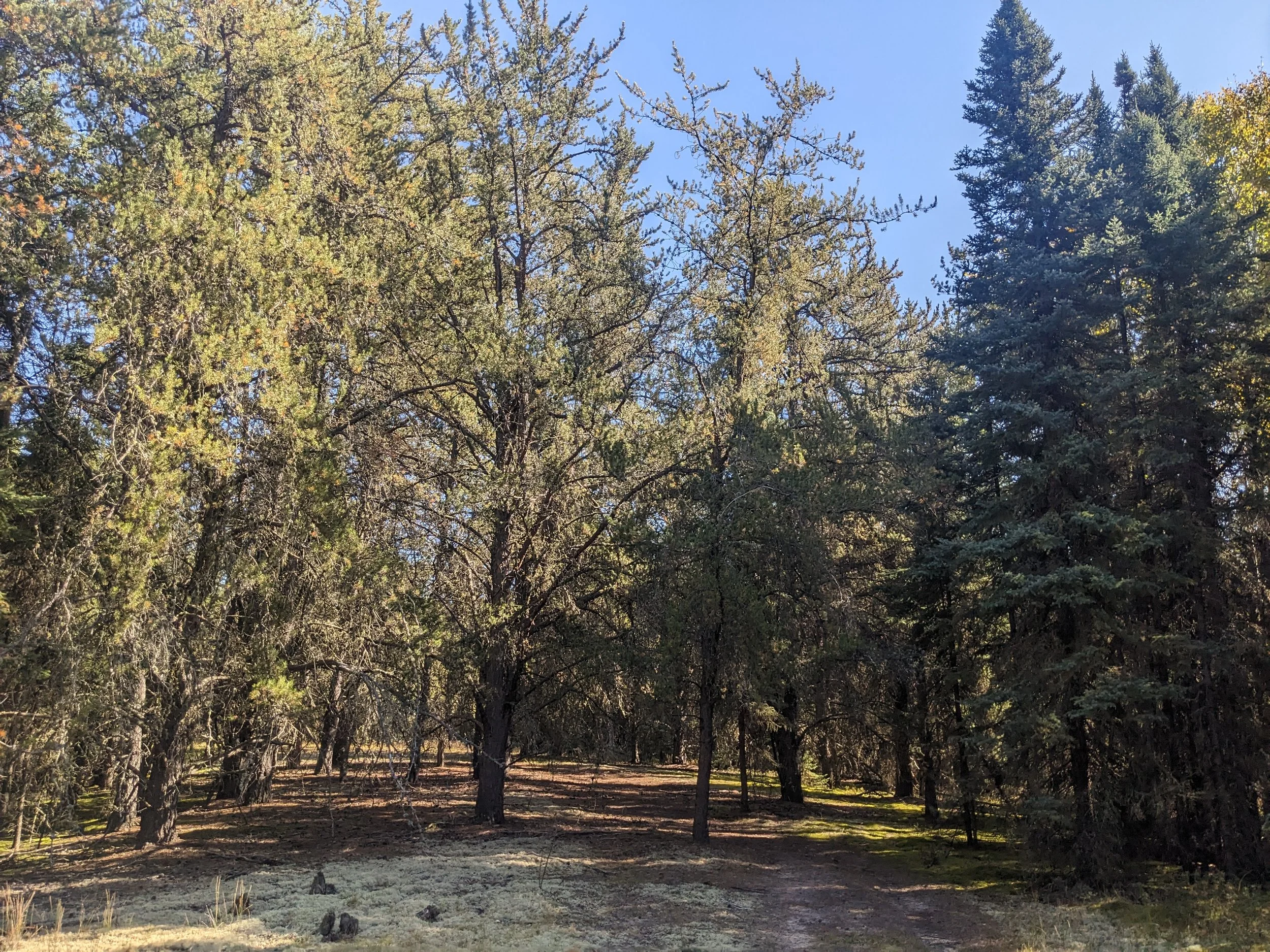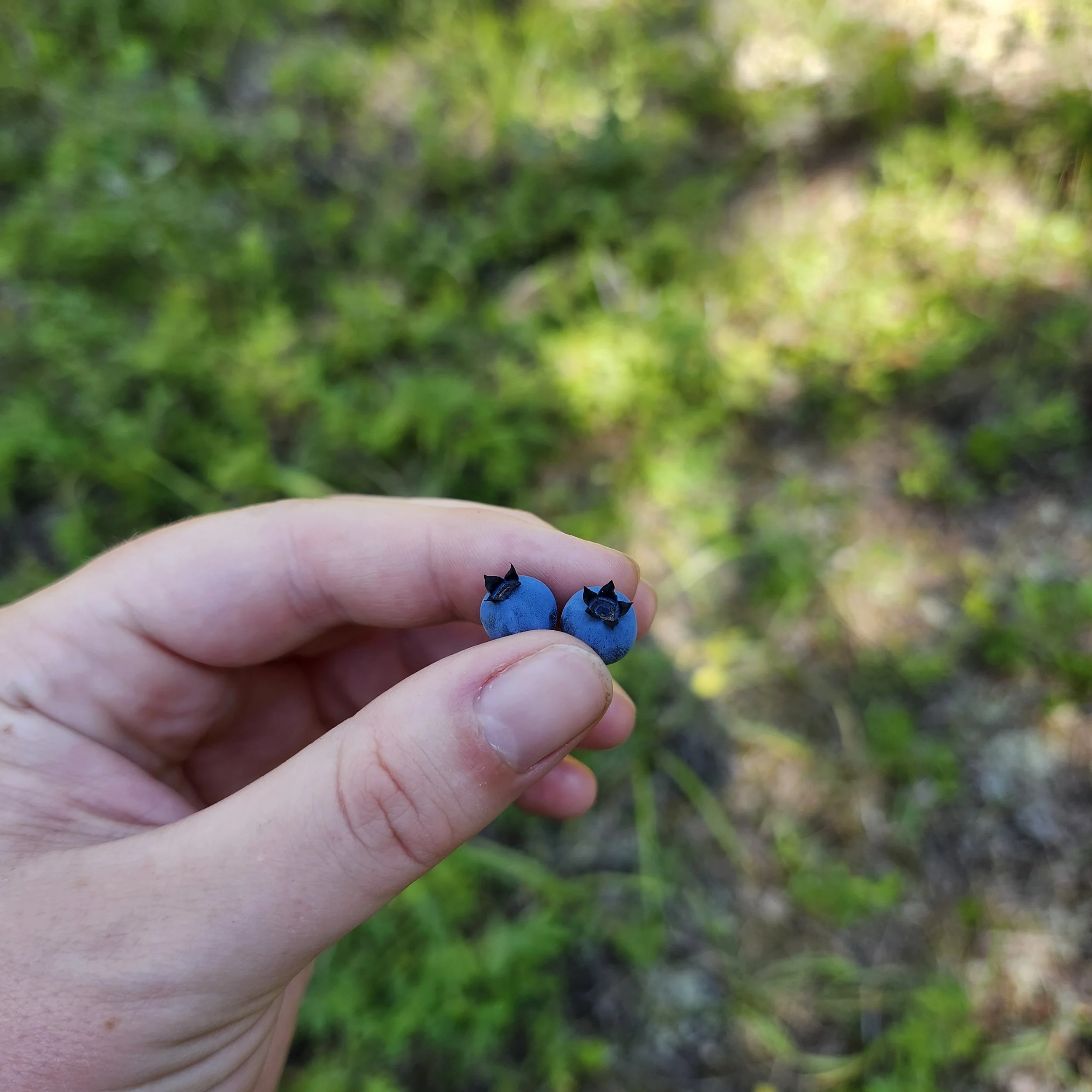As the bright green of early summer transitions to the mature greens and yellows of late summer, little blue gems make their presence known in the wet and acidic soils of the Parkland ecoregion. There’s another creature that prizes this natural treat besides humans: bears! Today, we’ll be talking about how blueberries feature in the lives of bears.
Blueberry Biology
A stand of Jack pine at an EALT conservation land, under which blueberries grow.
In Alberta, there is a plant with tiny, tasty blue berries that thrives where pine trees grow. They like the acidity that pine trees provide, yet prefer to stay out in the sun, so they position themselves alongside their tree friends, often spreading to form low shrubby thickets.
Wild blueberries growing on an EALT conservation land.
As a bog plant, they like to keep their feet wet, yet they don’t wish to be submerged. For this reason, they prefer well-drained sandy soil, and the higher ground of bogs and fens. Where conditions are right, these plants may be found on the prairies, within the Rockies, and throughout northern landscapes.
In spring, they fashion small, white bell-shaped flowers that mature to blue berry clusters in summer. Autumn is a showcase of lovely red leaves. Unlike many of their cousins, their leaves are covered with tiny hairs, and it is this feature that encourages us to call them “velvetleaf” blueberries, though they are known by many other names.
To distinguish this plant from the many other blueberry species in Canada, the scientific name, Vaccinium myrtilloides, has been applied. Velvetleaf blueberry has evolved with the natural occurrences of forest fire. Today, they are highly tolerant of fire and show up in abundance after such events.
Bear-y Buffet
A Black bear, captured by an EALT wildlife camera.
Bears of the Rocky Mountains, grizzlies and black bears, have also evolved with the dynamic nature of this landscape. They rely on forest fires, as well as avalanches and floods, because such disturbances to the landscape cultivate the diverse habitats bears rely on for food. This is also true for the bears found in the Edmonton area, however, black bears are the main species found in the region.
Grizzly bear grazing. Photo credit: Mike May
Most people think of bears as carnivores, but their diet is omnivorous, and largely plant based. It is estimated that 90% of a bear’s diet is plant matter, mainly berries & nuts. Blueberries are among their favourites and are critical to a bear’s diet. For bears, hibernation is followed by a season of breeding which coincides with the spring growth of grasses, tender flowering plants, legume roots, and bulbs. These make up the bulk of their spring, plant-based diet.
A bear den. Bears hibernate through the cold seasons, and become active when food is plentiful in the warm season.
In early July bears shift their focus from breeding to preparing for the winter cold, harbinger of hibernation. With berries maturing throughout summer, they become an all-important high-quality food for health and survival throughout the following life cycle. From early summer and on into fall, if not seen, their presence can be felt wherever these sun-loving plants flourish. Wild berries are more nutritious than their cultivated counterparts (lower in calories, higher in micronutrient and antioxidant content) and bears can eat up to 30 000 of these tasty morsels in a single day. For hours each day they forage to make up this 78 lbs daily quotient.
Places of food abundance - this is where it’s at for bears! The knowledge of a reliable food source, such as a large blueberry field, is passed down from generation to generation, and generations of bears will make the trek, sometimes more than 150 km beyond their home range, to gather and eat. Noses to the ground, young and old together scoop mouthfuls of berries, delicately plucking them from woody stems with their prehensile lips and their long manipulative tongues.
Bears, Blueberries, and Conservation
Bears love blueberries. We humans share this love. As we delight in the action of gathering this tasty fruit, we can also express our care for bears by using our knowledge, respecting where we are, and acting accordingly.
We are in bear country! Since colonization, much of the habitat grizzly and black bears rely on in the central Alberta region has been disturbed and fragmented by human activity: resource extraction activities, cities, roads, and other impacts have made it challenging for bears to live here.
Grizzlies have been extirpated from the Edmonton region, but black bears are consistently present on our conservation lands. We see them regularly on our wildlife cameras, highlighting the importance of conserving natural lands around Edmonton. You can assist us with our mission by donating, joining a stewardship event, or volunteering for one of our volunteer programs.
Thank you for reading our blog, and special thanks to Suzanne Matheson for writing it!
References:
Frame to Frame - Bob and Jean The World Through Our Lens. Black Bear Mom and Cubs Eat Blueberries in Algonquin Park. Retrieved (Dec 14, 2024), from https://frametoframe.ca/2014/08/black-bear-mom-cubs-eat-blue-berries-algonquin-park/ Government of Canada (2023, Mar 22).
Grizzly Bears Bears in the mountain national parks. Retrieved (Dec 14, 2024), from https://parks.canada.ca/pn-np/mtn/ours-bears/generaux-basics/grizzli-grizzly Hanna Seariac (2023, March 14).
What wild bears can teach us about healthy eating. Retrieved (Dec 14, 2024), from https://money.yahoo.com/wild-bears-teach-us-healthy-123700650.html Ken Ilgunas (2009, Aug 06).
Berries and black bears. Retrieved (Dec 14, 2024), from https://www.kenilgunas.com/post/berries-and-black-bears Native Plant Trush GO BOTANY (2024).
Vaccinium myrtilloides - velvet-leaved blueberry. Retrieved (Dec 14, 2024), from https://gobotany.nativeplanttrust.org/species/vaccinium/myrtilloides/ Ontario Parks (2023, July 03).
It’s July - What are the bears up to? Retrieved (Dec 14, 2024), from https://www.ontarioparks.ca/parksblog/black-bears-july/ Prairie Gardens (2023).
The Art of Growing Blueberries in Alberta. Retrieved (Dec 14, 2024), from https://prairiegardens.org/garden-centre/the-art-of-growing-blueberries-in-alberta/ Raymond Sewell (2024, Aug 09).
Bear Medicine. Retrieved (Dec 14, 2024), from https://niche-canada.org/2024/08/09/bear-medicine/ Wikipedia (2024, Aug 08). Vaccinium myrtilloides. Retrieved (Dec 14, 2024), from https://en.wikipedia.org/wiki/Vaccinium_myrtilloides





